PPMP20008 Project Management: Course Reflection & Lessons
VerifiedAdded on 2023/06/04
|12
|1894
|182
Report
AI Summary
This report reflects on lessons learned during a project management course (PPMP20008), focusing on the initiation and planning phases. It outlines a framework for gathering and documenting lessons, comparing planned actions with actual events. The report identifies key lessons related to the design and implementation phases, emphasizing the importance of risk planning, stakeholder engagement, and establishing success metrics. Improvement strategies are proposed for each lesson, including risk analysis, traceability of implemented activities, and verification/validation processes. The conclusion highlights the significance of documentation in project management and the understanding of project planning stages for project success. Desklib offers a range of resources, including solved assignments and past papers, to support students in their academic endeavors.
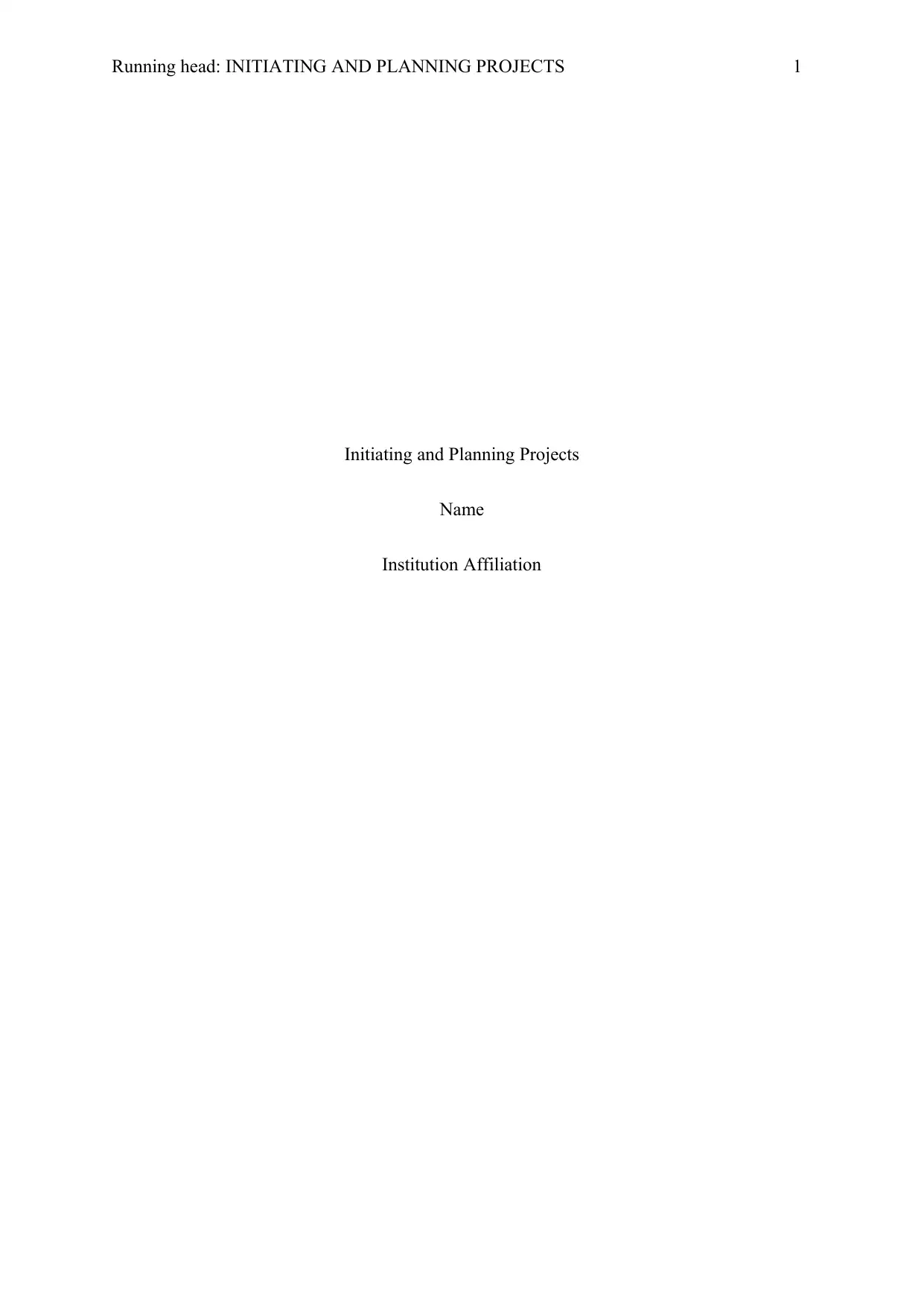
Running head: INITIATING AND PLANNING PROJECTS 1
Initiating and Planning Projects
Name
Institution Affiliation
Initiating and Planning Projects
Name
Institution Affiliation
Paraphrase This Document
Need a fresh take? Get an instant paraphrase of this document with our AI Paraphraser
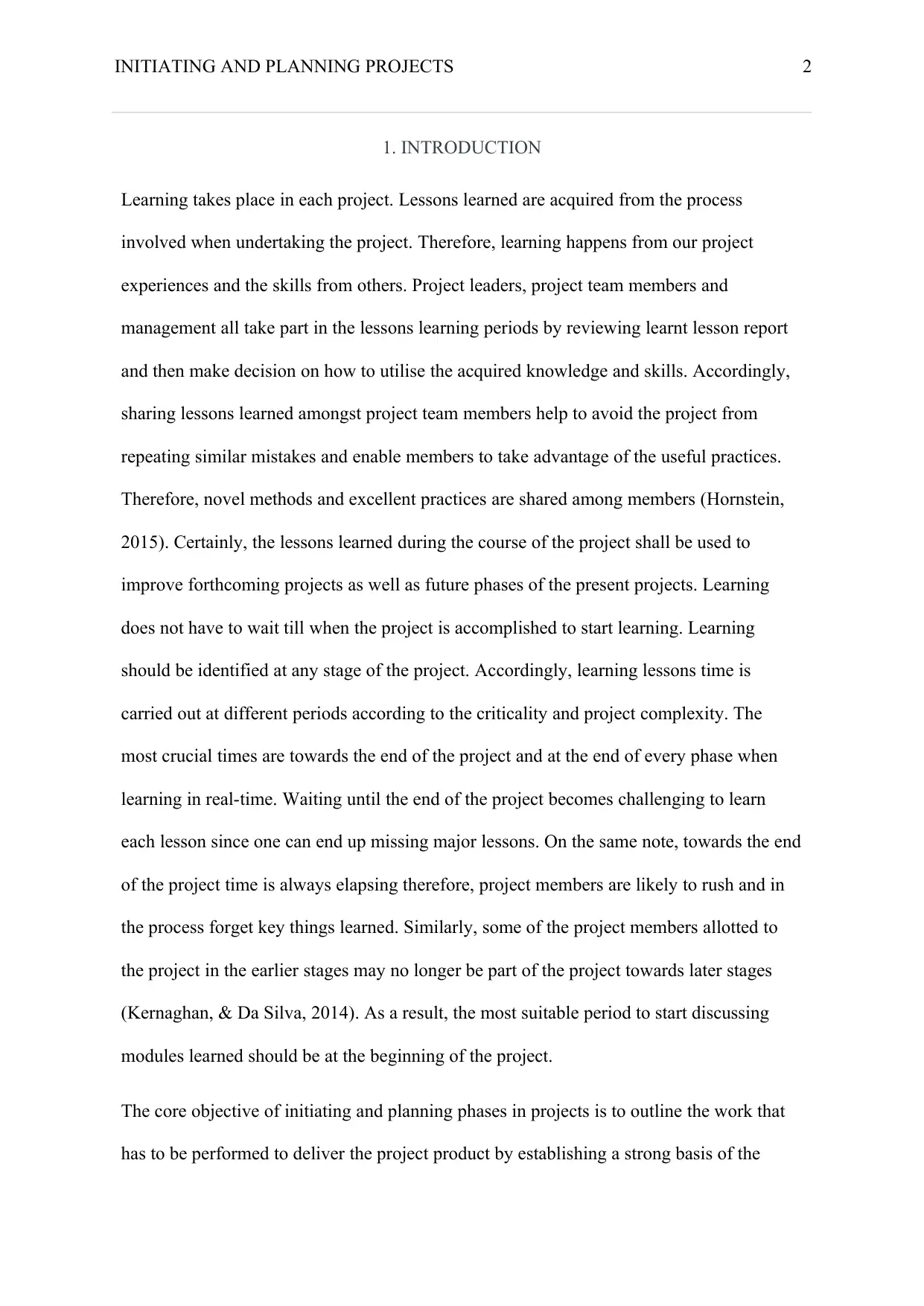
INITIATING AND PLANNING PROJECTS 2
1. INTRODUCTION
Learning takes place in each project. Lessons learned are acquired from the process
involved when undertaking the project. Therefore, learning happens from our project
experiences and the skills from others. Project leaders, project team members and
management all take part in the lessons learning periods by reviewing learnt lesson report
and then make decision on how to utilise the acquired knowledge and skills. Accordingly,
sharing lessons learned amongst project team members help to avoid the project from
repeating similar mistakes and enable members to take advantage of the useful practices.
Therefore, novel methods and excellent practices are shared among members (Hornstein,
2015). Certainly, the lessons learned during the course of the project shall be used to
improve forthcoming projects as well as future phases of the present projects. Learning
does not have to wait till when the project is accomplished to start learning. Learning
should be identified at any stage of the project. Accordingly, learning lessons time is
carried out at different periods according to the criticality and project complexity. The
most crucial times are towards the end of the project and at the end of every phase when
learning in real-time. Waiting until the end of the project becomes challenging to learn
each lesson since one can end up missing major lessons. On the same note, towards the end
of the project time is always elapsing therefore, project members are likely to rush and in
the process forget key things learned. Similarly, some of the project members allotted to
the project in the earlier stages may no longer be part of the project towards later stages
(Kernaghan, & Da Silva, 2014). As a result, the most suitable period to start discussing
modules learned should be at the beginning of the project.
The core objective of initiating and planning phases in projects is to outline the work that
has to be performed to deliver the project product by establishing a strong basis of the
1. INTRODUCTION
Learning takes place in each project. Lessons learned are acquired from the process
involved when undertaking the project. Therefore, learning happens from our project
experiences and the skills from others. Project leaders, project team members and
management all take part in the lessons learning periods by reviewing learnt lesson report
and then make decision on how to utilise the acquired knowledge and skills. Accordingly,
sharing lessons learned amongst project team members help to avoid the project from
repeating similar mistakes and enable members to take advantage of the useful practices.
Therefore, novel methods and excellent practices are shared among members (Hornstein,
2015). Certainly, the lessons learned during the course of the project shall be used to
improve forthcoming projects as well as future phases of the present projects. Learning
does not have to wait till when the project is accomplished to start learning. Learning
should be identified at any stage of the project. Accordingly, learning lessons time is
carried out at different periods according to the criticality and project complexity. The
most crucial times are towards the end of the project and at the end of every phase when
learning in real-time. Waiting until the end of the project becomes challenging to learn
each lesson since one can end up missing major lessons. On the same note, towards the end
of the project time is always elapsing therefore, project members are likely to rush and in
the process forget key things learned. Similarly, some of the project members allotted to
the project in the earlier stages may no longer be part of the project towards later stages
(Kernaghan, & Da Silva, 2014). As a result, the most suitable period to start discussing
modules learned should be at the beginning of the project.
The core objective of initiating and planning phases in projects is to outline the work that
has to be performed to deliver the project product by establishing a strong basis of the
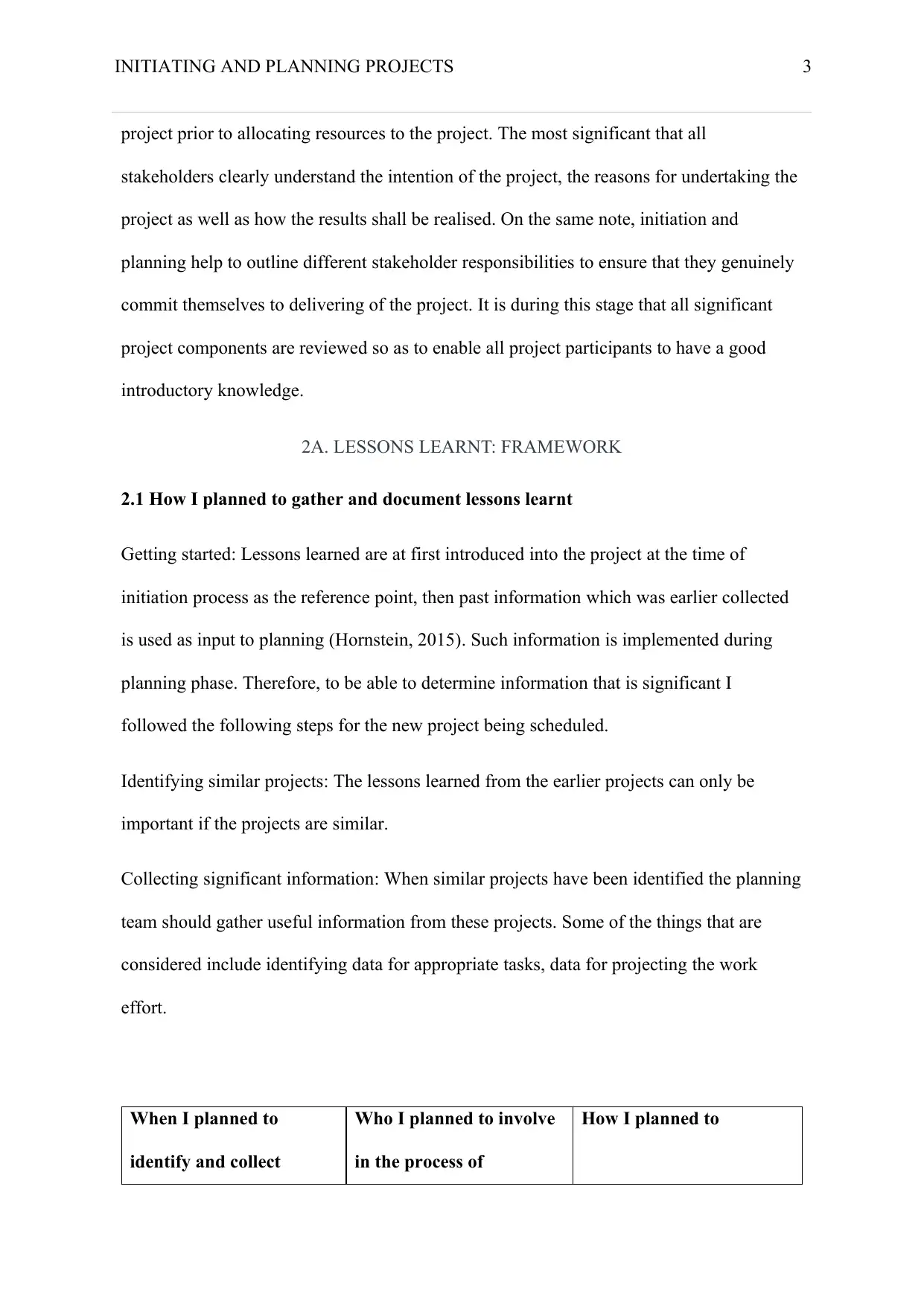
INITIATING AND PLANNING PROJECTS 3
project prior to allocating resources to the project. The most significant that all
stakeholders clearly understand the intention of the project, the reasons for undertaking the
project as well as how the results shall be realised. On the same note, initiation and
planning help to outline different stakeholder responsibilities to ensure that they genuinely
commit themselves to delivering of the project. It is during this stage that all significant
project components are reviewed so as to enable all project participants to have a good
introductory knowledge.
2A. LESSONS LEARNT: FRAMEWORK
2.1 How I planned to gather and document lessons learnt
Getting started: Lessons learned are at first introduced into the project at the time of
initiation process as the reference point, then past information which was earlier collected
is used as input to planning (Hornstein, 2015). Such information is implemented during
planning phase. Therefore, to be able to determine information that is significant I
followed the following steps for the new project being scheduled.
Identifying similar projects: The lessons learned from the earlier projects can only be
important if the projects are similar.
Collecting significant information: When similar projects have been identified the planning
team should gather useful information from these projects. Some of the things that are
considered include identifying data for appropriate tasks, data for projecting the work
effort.
When I planned to
identify and collect
Who I planned to involve
in the process of
How I planned to
project prior to allocating resources to the project. The most significant that all
stakeholders clearly understand the intention of the project, the reasons for undertaking the
project as well as how the results shall be realised. On the same note, initiation and
planning help to outline different stakeholder responsibilities to ensure that they genuinely
commit themselves to delivering of the project. It is during this stage that all significant
project components are reviewed so as to enable all project participants to have a good
introductory knowledge.
2A. LESSONS LEARNT: FRAMEWORK
2.1 How I planned to gather and document lessons learnt
Getting started: Lessons learned are at first introduced into the project at the time of
initiation process as the reference point, then past information which was earlier collected
is used as input to planning (Hornstein, 2015). Such information is implemented during
planning phase. Therefore, to be able to determine information that is significant I
followed the following steps for the new project being scheduled.
Identifying similar projects: The lessons learned from the earlier projects can only be
important if the projects are similar.
Collecting significant information: When similar projects have been identified the planning
team should gather useful information from these projects. Some of the things that are
considered include identifying data for appropriate tasks, data for projecting the work
effort.
When I planned to
identify and collect
Who I planned to involve
in the process of
How I planned to
⊘ This is a preview!⊘
Do you want full access?
Subscribe today to unlock all pages.

Trusted by 1+ million students worldwide
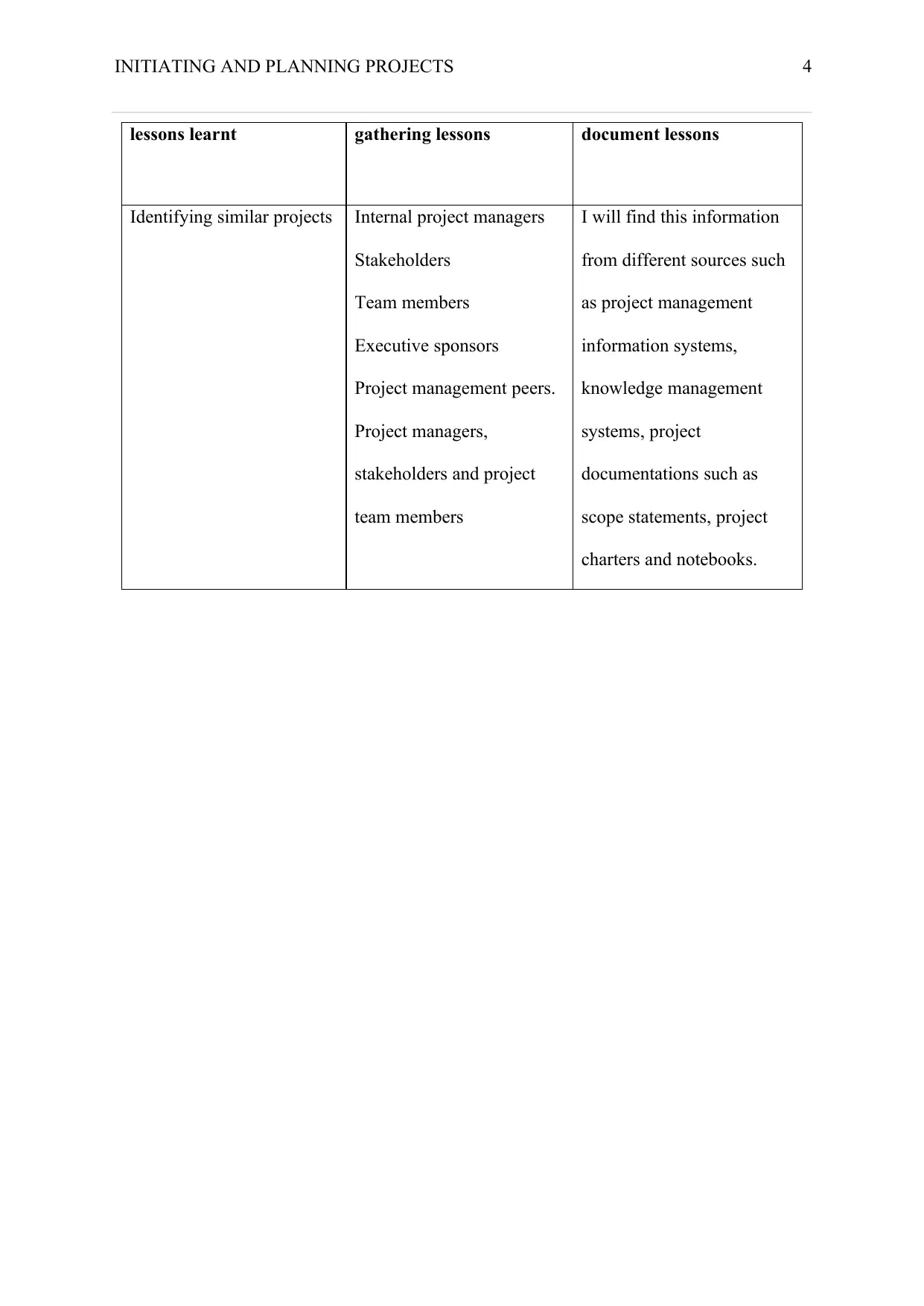
INITIATING AND PLANNING PROJECTS 4
lessons learnt gathering lessons document lessons
Identifying similar projects Internal project managers
Stakeholders
Team members
Executive sponsors
Project management peers.
Project managers,
stakeholders and project
team members
I will find this information
from different sources such
as project management
information systems,
knowledge management
systems, project
documentations such as
scope statements, project
charters and notebooks.
lessons learnt gathering lessons document lessons
Identifying similar projects Internal project managers
Stakeholders
Team members
Executive sponsors
Project management peers.
Project managers,
stakeholders and project
team members
I will find this information
from different sources such
as project management
information systems,
knowledge management
systems, project
documentations such as
scope statements, project
charters and notebooks.
Paraphrase This Document
Need a fresh take? Get an instant paraphrase of this document with our AI Paraphraser
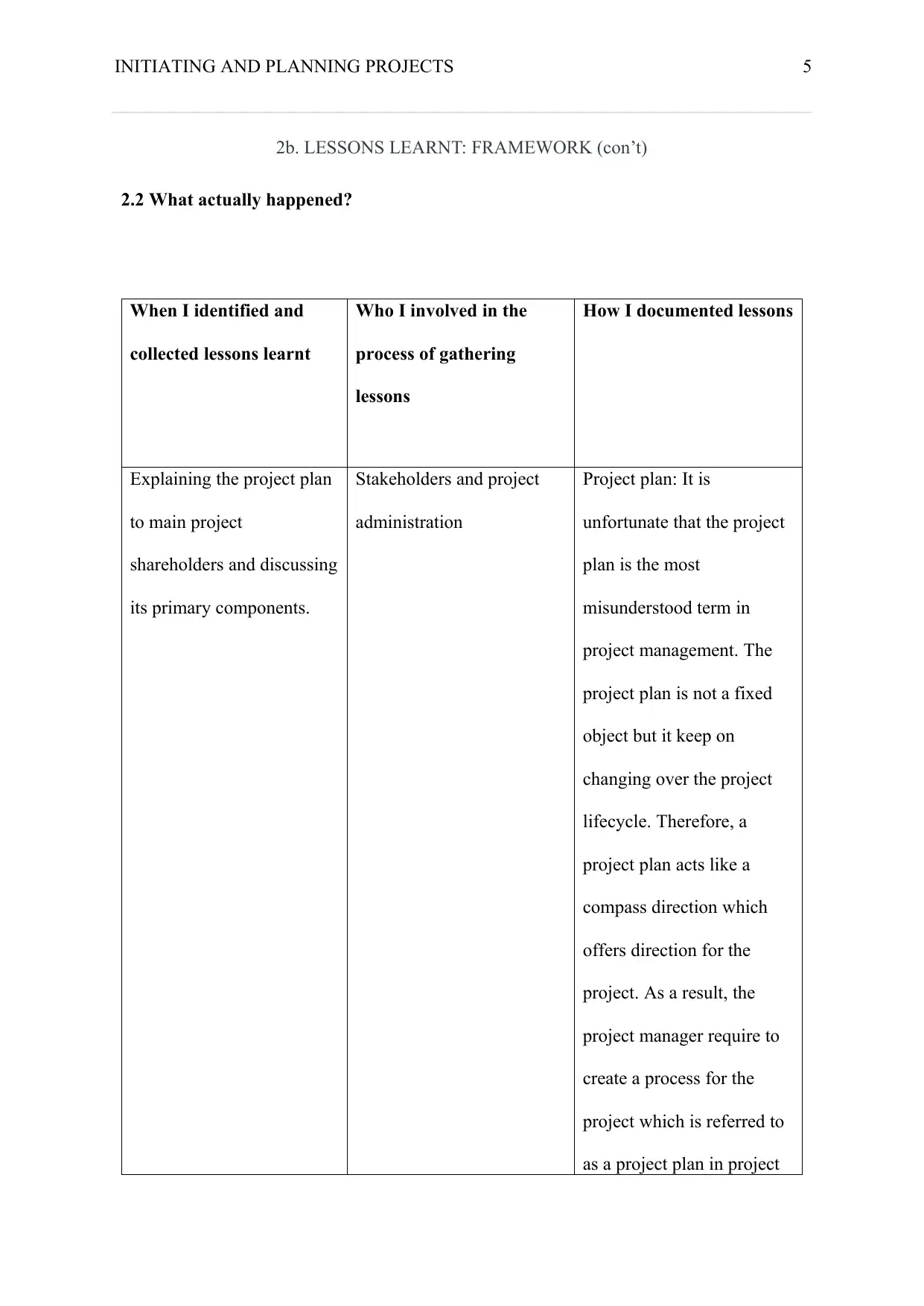
INITIATING AND PLANNING PROJECTS 5
2b. LESSONS LEARNT: FRAMEWORK (con’t)
2.2 What actually happened?
When I identified and
collected lessons learnt
Who I involved in the
process of gathering
lessons
How I documented lessons
Explaining the project plan
to main project
shareholders and discussing
its primary components.
Stakeholders and project
administration
Project plan: It is
unfortunate that the project
plan is the most
misunderstood term in
project management. The
project plan is not a fixed
object but it keep on
changing over the project
lifecycle. Therefore, a
project plan acts like a
compass direction which
offers direction for the
project. As a result, the
project manager require to
create a process for the
project which is referred to
as a project plan in project
2b. LESSONS LEARNT: FRAMEWORK (con’t)
2.2 What actually happened?
When I identified and
collected lessons learnt
Who I involved in the
process of gathering
lessons
How I documented lessons
Explaining the project plan
to main project
shareholders and discussing
its primary components.
Stakeholders and project
administration
Project plan: It is
unfortunate that the project
plan is the most
misunderstood term in
project management. The
project plan is not a fixed
object but it keep on
changing over the project
lifecycle. Therefore, a
project plan acts like a
compass direction which
offers direction for the
project. As a result, the
project manager require to
create a process for the
project which is referred to
as a project plan in project
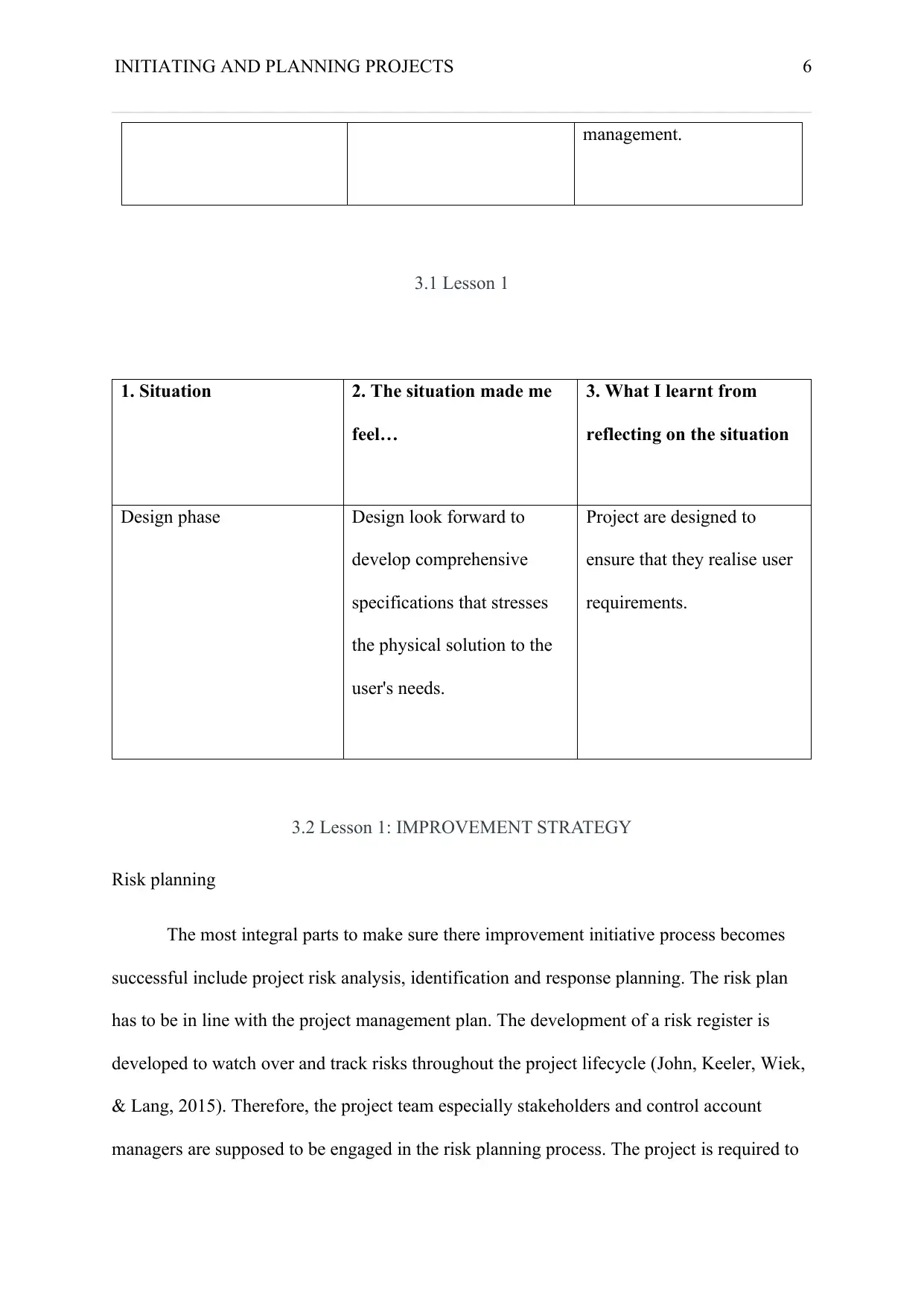
INITIATING AND PLANNING PROJECTS 6
management.
3.1 Lesson 1
1. Situation 2. The situation made me
feel…
3. What I learnt from
reflecting on the situation
Design phase Design look forward to
develop comprehensive
specifications that stresses
the physical solution to the
user's needs.
Project are designed to
ensure that they realise user
requirements.
3.2 Lesson 1: IMPROVEMENT STRATEGY
Risk planning
The most integral parts to make sure there improvement initiative process becomes
successful include project risk analysis, identification and response planning. The risk plan
has to be in line with the project management plan. The development of a risk register is
developed to watch over and track risks throughout the project lifecycle (John, Keeler, Wiek,
& Lang, 2015). Therefore, the project team especially stakeholders and control account
managers are supposed to be engaged in the risk planning process. The project is required to
management.
3.1 Lesson 1
1. Situation 2. The situation made me
feel…
3. What I learnt from
reflecting on the situation
Design phase Design look forward to
develop comprehensive
specifications that stresses
the physical solution to the
user's needs.
Project are designed to
ensure that they realise user
requirements.
3.2 Lesson 1: IMPROVEMENT STRATEGY
Risk planning
The most integral parts to make sure there improvement initiative process becomes
successful include project risk analysis, identification and response planning. The risk plan
has to be in line with the project management plan. The development of a risk register is
developed to watch over and track risks throughout the project lifecycle (John, Keeler, Wiek,
& Lang, 2015). Therefore, the project team especially stakeholders and control account
managers are supposed to be engaged in the risk planning process. The project is required to
⊘ This is a preview!⊘
Do you want full access?
Subscribe today to unlock all pages.

Trusted by 1+ million students worldwide
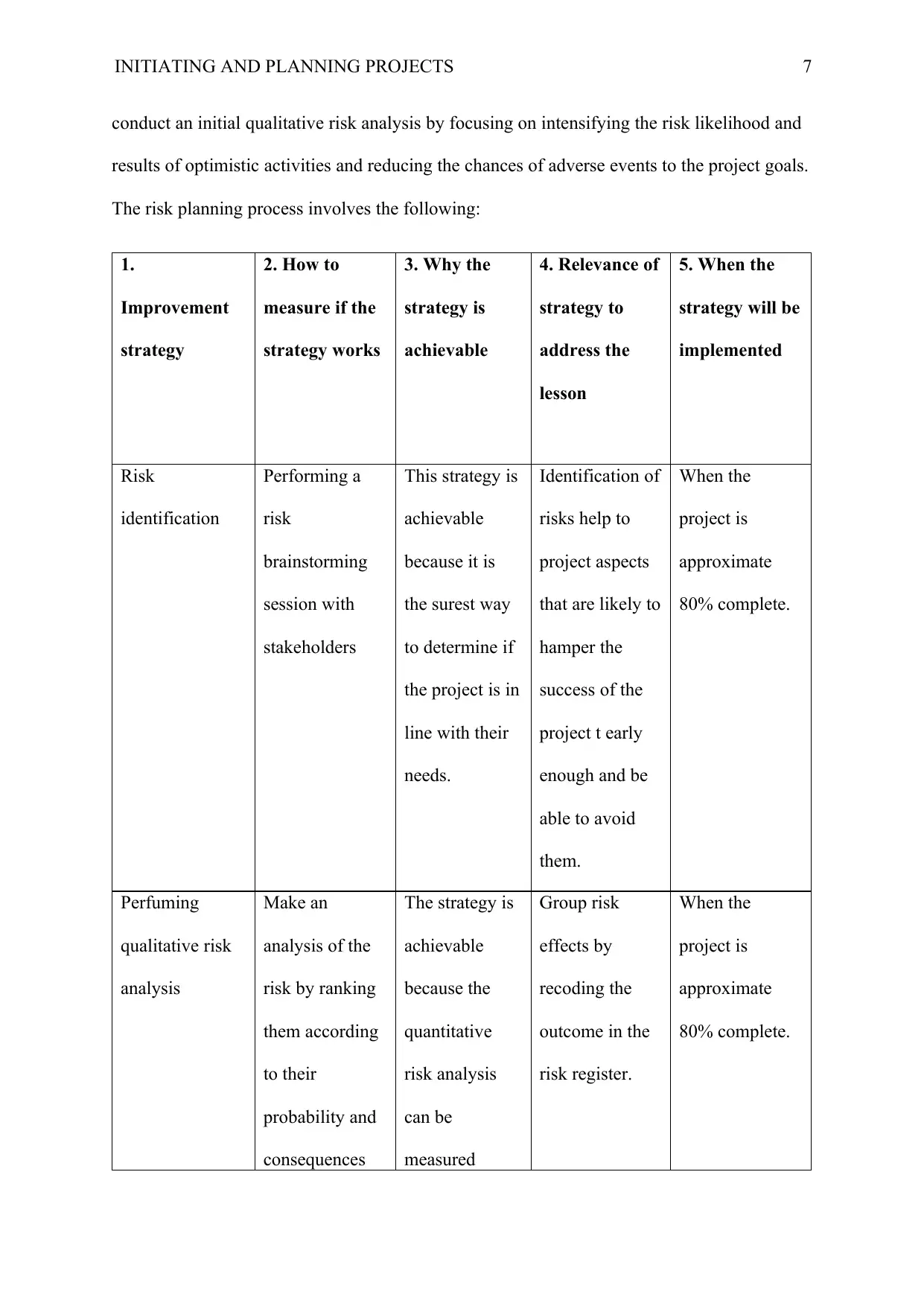
INITIATING AND PLANNING PROJECTS 7
conduct an initial qualitative risk analysis by focusing on intensifying the risk likelihood and
results of optimistic activities and reducing the chances of adverse events to the project goals.
The risk planning process involves the following:
1.
Improvement
strategy
2. How to
measure if the
strategy works
3. Why the
strategy is
achievable
4. Relevance of
strategy to
address the
lesson
5. When the
strategy will be
implemented
Risk
identification
Performing a
risk
brainstorming
session with
stakeholders
This strategy is
achievable
because it is
the surest way
to determine if
the project is in
line with their
needs.
Identification of
risks help to
project aspects
that are likely to
hamper the
success of the
project t early
enough and be
able to avoid
them.
When the
project is
approximate
80% complete.
Perfuming
qualitative risk
analysis
Make an
analysis of the
risk by ranking
them according
to their
probability and
consequences
The strategy is
achievable
because the
quantitative
risk analysis
can be
measured
Group risk
effects by
recoding the
outcome in the
risk register.
When the
project is
approximate
80% complete.
conduct an initial qualitative risk analysis by focusing on intensifying the risk likelihood and
results of optimistic activities and reducing the chances of adverse events to the project goals.
The risk planning process involves the following:
1.
Improvement
strategy
2. How to
measure if the
strategy works
3. Why the
strategy is
achievable
4. Relevance of
strategy to
address the
lesson
5. When the
strategy will be
implemented
Risk
identification
Performing a
risk
brainstorming
session with
stakeholders
This strategy is
achievable
because it is
the surest way
to determine if
the project is in
line with their
needs.
Identification of
risks help to
project aspects
that are likely to
hamper the
success of the
project t early
enough and be
able to avoid
them.
When the
project is
approximate
80% complete.
Perfuming
qualitative risk
analysis
Make an
analysis of the
risk by ranking
them according
to their
probability and
consequences
The strategy is
achievable
because the
quantitative
risk analysis
can be
measured
Group risk
effects by
recoding the
outcome in the
risk register.
When the
project is
approximate
80% complete.
Paraphrase This Document
Need a fresh take? Get an instant paraphrase of this document with our AI Paraphraser
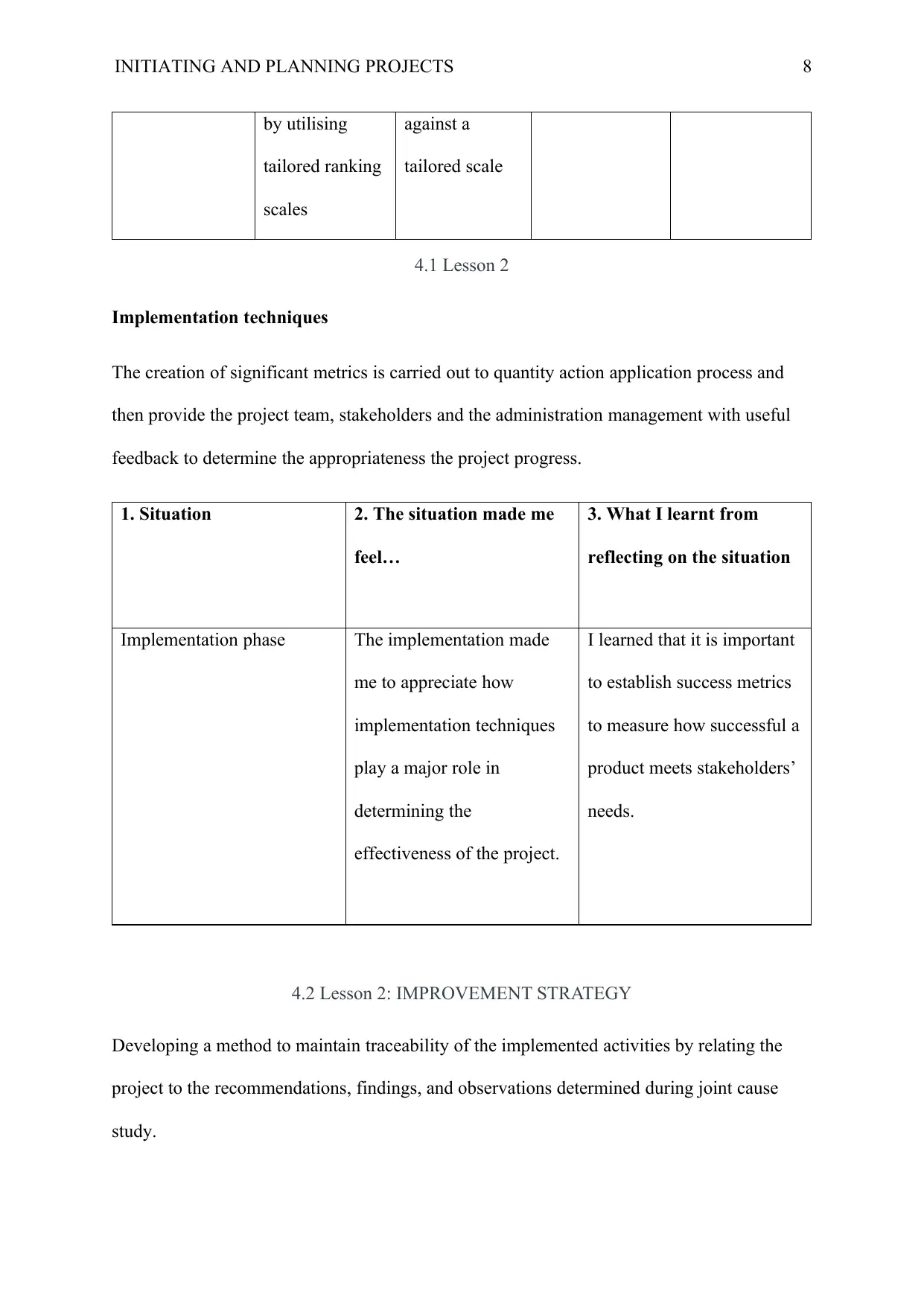
INITIATING AND PLANNING PROJECTS 8
by utilising
tailored ranking
scales
against a
tailored scale
4.1 Lesson 2
Implementation techniques
The creation of significant metrics is carried out to quantity action application process and
then provide the project team, stakeholders and the administration management with useful
feedback to determine the appropriateness the project progress.
1. Situation 2. The situation made me
feel…
3. What I learnt from
reflecting on the situation
Implementation phase The implementation made
me to appreciate how
implementation techniques
play a major role in
determining the
effectiveness of the project.
I learned that it is important
to establish success metrics
to measure how successful a
product meets stakeholders’
needs.
4.2 Lesson 2: IMPROVEMENT STRATEGY
Developing a method to maintain traceability of the implemented activities by relating the
project to the recommendations, findings, and observations determined during joint cause
study.
by utilising
tailored ranking
scales
against a
tailored scale
4.1 Lesson 2
Implementation techniques
The creation of significant metrics is carried out to quantity action application process and
then provide the project team, stakeholders and the administration management with useful
feedback to determine the appropriateness the project progress.
1. Situation 2. The situation made me
feel…
3. What I learnt from
reflecting on the situation
Implementation phase The implementation made
me to appreciate how
implementation techniques
play a major role in
determining the
effectiveness of the project.
I learned that it is important
to establish success metrics
to measure how successful a
product meets stakeholders’
needs.
4.2 Lesson 2: IMPROVEMENT STRATEGY
Developing a method to maintain traceability of the implemented activities by relating the
project to the recommendations, findings, and observations determined during joint cause
study.
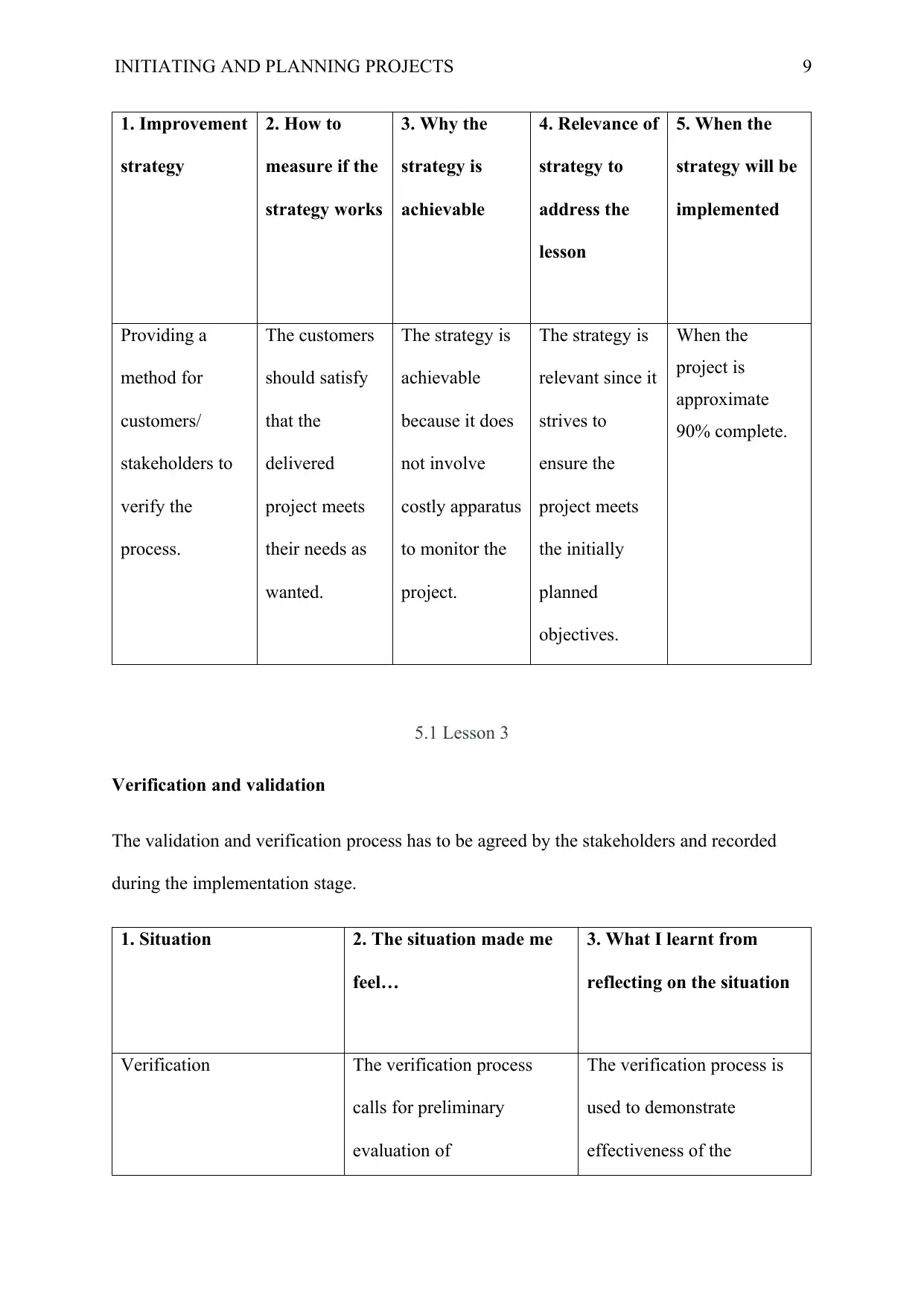
INITIATING AND PLANNING PROJECTS 9
1. Improvement
strategy
2. How to
measure if the
strategy works
3. Why the
strategy is
achievable
4. Relevance of
strategy to
address the
lesson
5. When the
strategy will be
implemented
Providing a
method for
customers/
stakeholders to
verify the
process.
The customers
should satisfy
that the
delivered
project meets
their needs as
wanted.
The strategy is
achievable
because it does
not involve
costly apparatus
to monitor the
project.
The strategy is
relevant since it
strives to
ensure the
project meets
the initially
planned
objectives.
When the
project is
approximate
90% complete.
5.1 Lesson 3
Verification and validation
The validation and verification process has to be agreed by the stakeholders and recorded
during the implementation stage.
1. Situation 2. The situation made me
feel…
3. What I learnt from
reflecting on the situation
Verification The verification process
calls for preliminary
evaluation of
The verification process is
used to demonstrate
effectiveness of the
1. Improvement
strategy
2. How to
measure if the
strategy works
3. Why the
strategy is
achievable
4. Relevance of
strategy to
address the
lesson
5. When the
strategy will be
implemented
Providing a
method for
customers/
stakeholders to
verify the
process.
The customers
should satisfy
that the
delivered
project meets
their needs as
wanted.
The strategy is
achievable
because it does
not involve
costly apparatus
to monitor the
project.
The strategy is
relevant since it
strives to
ensure the
project meets
the initially
planned
objectives.
When the
project is
approximate
90% complete.
5.1 Lesson 3
Verification and validation
The validation and verification process has to be agreed by the stakeholders and recorded
during the implementation stage.
1. Situation 2. The situation made me
feel…
3. What I learnt from
reflecting on the situation
Verification The verification process
calls for preliminary
evaluation of
The verification process is
used to demonstrate
effectiveness of the
⊘ This is a preview!⊘
Do you want full access?
Subscribe today to unlock all pages.

Trusted by 1+ million students worldwide
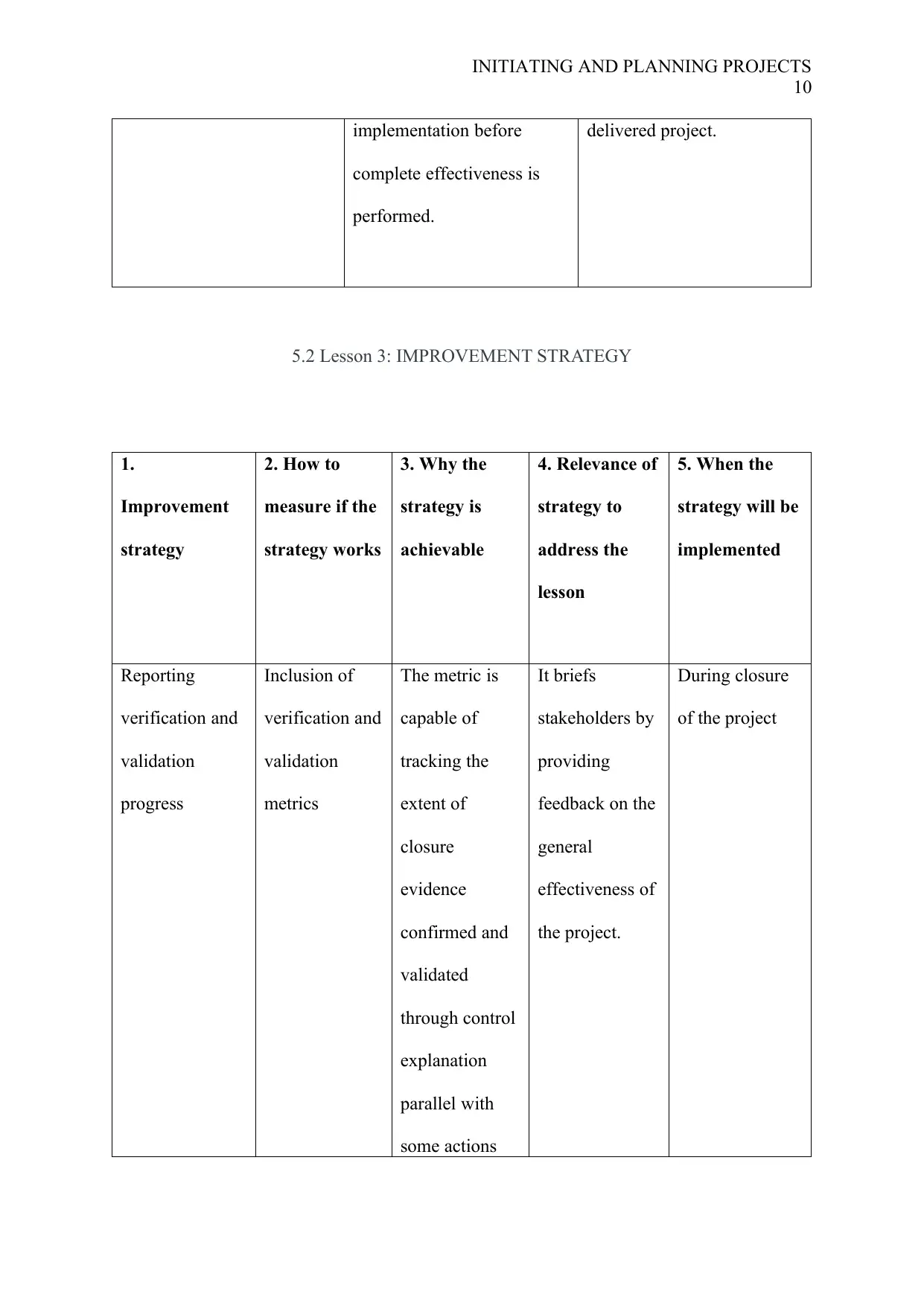
INITIATING AND PLANNING PROJECTS
10
implementation before
complete effectiveness is
performed.
delivered project.
5.2 Lesson 3: IMPROVEMENT STRATEGY
1.
Improvement
strategy
2. How to
measure if the
strategy works
3. Why the
strategy is
achievable
4. Relevance of
strategy to
address the
lesson
5. When the
strategy will be
implemented
Reporting
verification and
validation
progress
Inclusion of
verification and
validation
metrics
The metric is
capable of
tracking the
extent of
closure
evidence
confirmed and
validated
through control
explanation
parallel with
some actions
It briefs
stakeholders by
providing
feedback on the
general
effectiveness of
the project.
During closure
of the project
10
implementation before
complete effectiveness is
performed.
delivered project.
5.2 Lesson 3: IMPROVEMENT STRATEGY
1.
Improvement
strategy
2. How to
measure if the
strategy works
3. Why the
strategy is
achievable
4. Relevance of
strategy to
address the
lesson
5. When the
strategy will be
implemented
Reporting
verification and
validation
progress
Inclusion of
verification and
validation
metrics
The metric is
capable of
tracking the
extent of
closure
evidence
confirmed and
validated
through control
explanation
parallel with
some actions
It briefs
stakeholders by
providing
feedback on the
general
effectiveness of
the project.
During closure
of the project
Paraphrase This Document
Need a fresh take? Get an instant paraphrase of this document with our AI Paraphraser
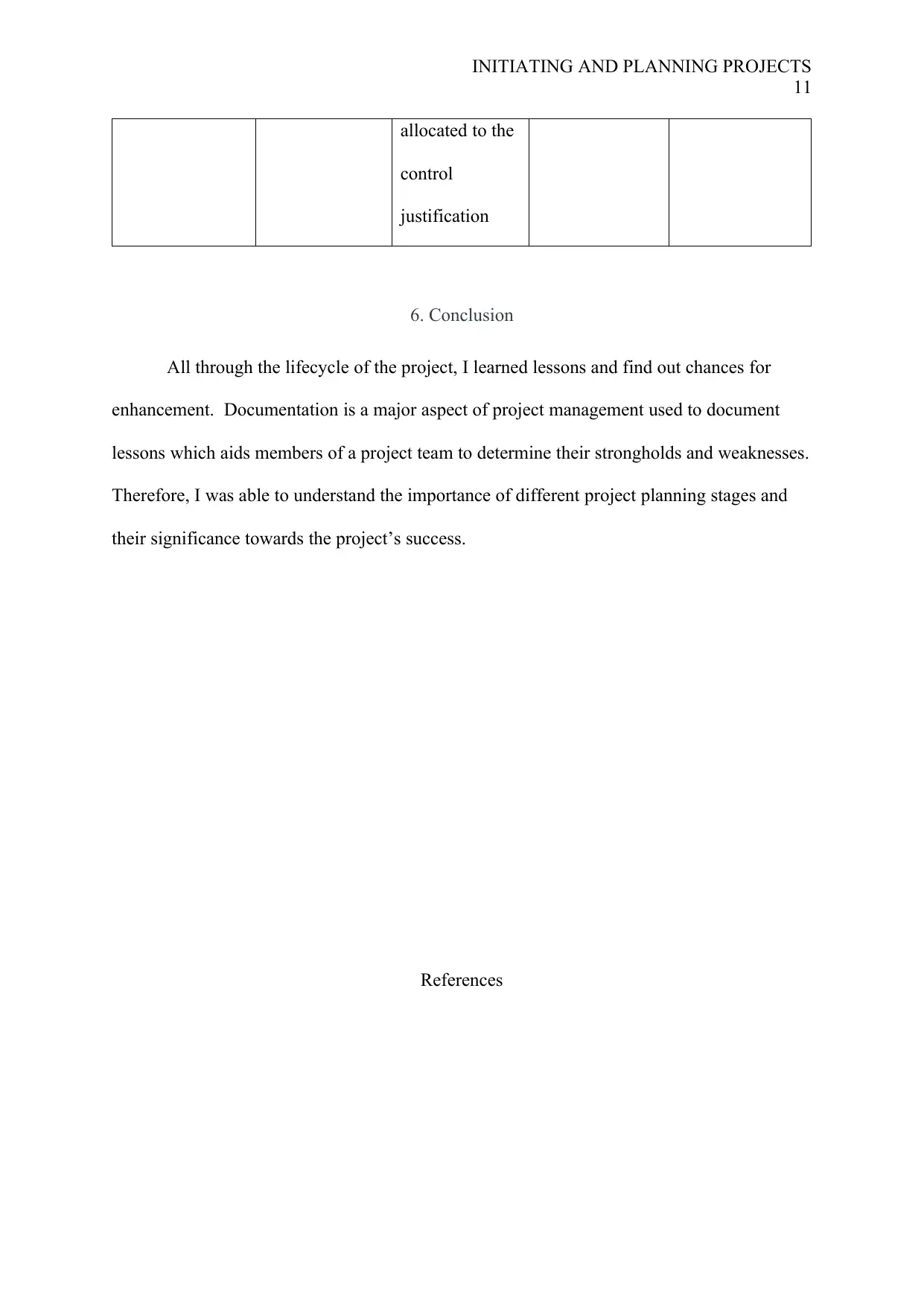
INITIATING AND PLANNING PROJECTS
11
allocated to the
control
justification
6. Conclusion
All through the lifecycle of the project, I learned lessons and find out chances for
enhancement. Documentation is a major aspect of project management used to document
lessons which aids members of a project team to determine their strongholds and weaknesses.
Therefore, I was able to understand the importance of different project planning stages and
their significance towards the project’s success.
References
11
allocated to the
control
justification
6. Conclusion
All through the lifecycle of the project, I learned lessons and find out chances for
enhancement. Documentation is a major aspect of project management used to document
lessons which aids members of a project team to determine their strongholds and weaknesses.
Therefore, I was able to understand the importance of different project planning stages and
their significance towards the project’s success.
References
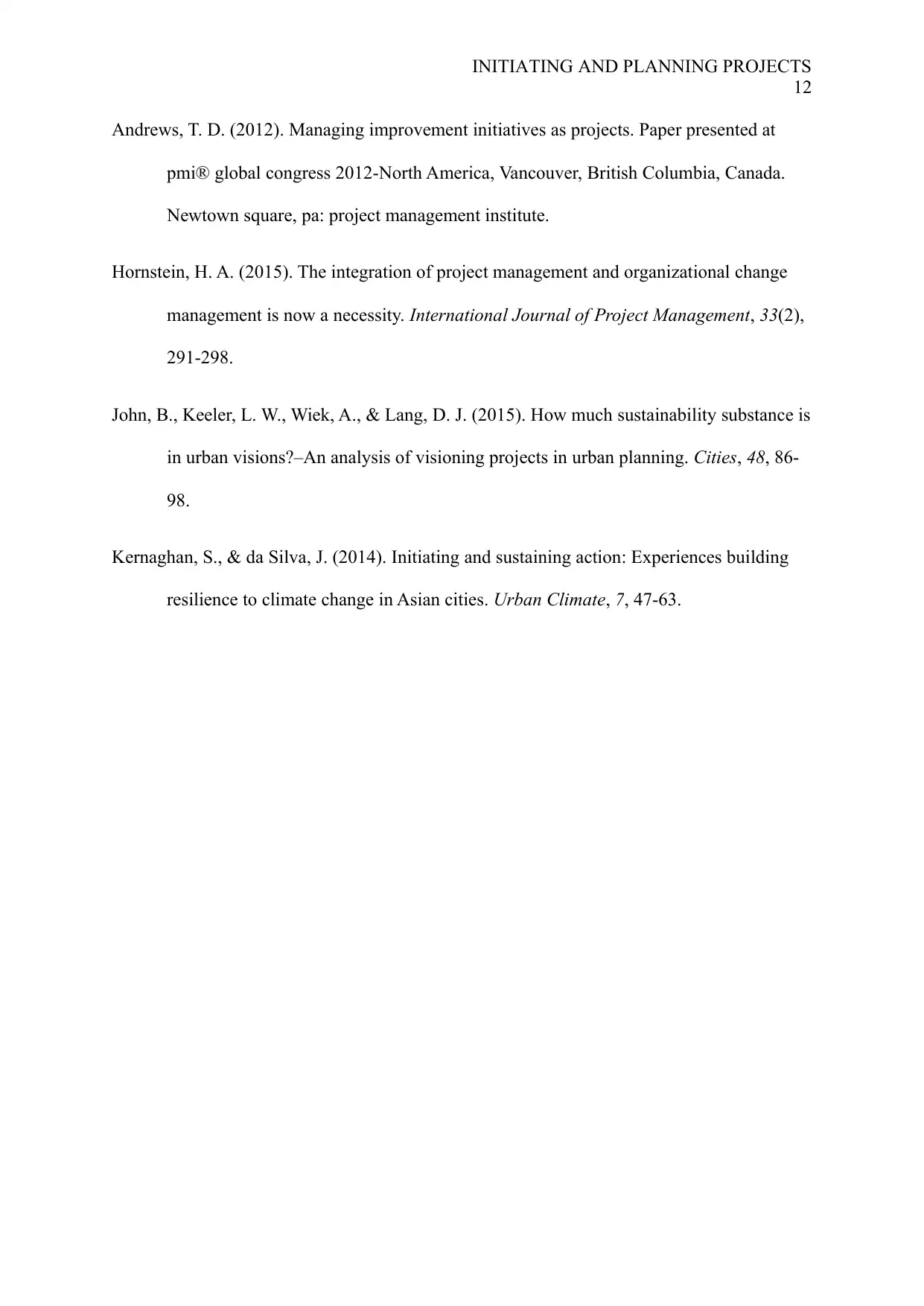
INITIATING AND PLANNING PROJECTS
12
Andrews, T. D. (2012). Managing improvement initiatives as projects. Paper presented at
pmi® global congress 2012-North America, Vancouver, British Columbia, Canada.
Newtown square, pa: project management institute.
Hornstein, H. A. (2015). The integration of project management and organizational change
management is now a necessity. International Journal of Project Management, 33(2),
291-298.
John, B., Keeler, L. W., Wiek, A., & Lang, D. J. (2015). How much sustainability substance is
in urban visions?–An analysis of visioning projects in urban planning. Cities, 48, 86-
98.
Kernaghan, S., & da Silva, J. (2014). Initiating and sustaining action: Experiences building
resilience to climate change in Asian cities. Urban Climate, 7, 47-63.
12
Andrews, T. D. (2012). Managing improvement initiatives as projects. Paper presented at
pmi® global congress 2012-North America, Vancouver, British Columbia, Canada.
Newtown square, pa: project management institute.
Hornstein, H. A. (2015). The integration of project management and organizational change
management is now a necessity. International Journal of Project Management, 33(2),
291-298.
John, B., Keeler, L. W., Wiek, A., & Lang, D. J. (2015). How much sustainability substance is
in urban visions?–An analysis of visioning projects in urban planning. Cities, 48, 86-
98.
Kernaghan, S., & da Silva, J. (2014). Initiating and sustaining action: Experiences building
resilience to climate change in Asian cities. Urban Climate, 7, 47-63.
⊘ This is a preview!⊘
Do you want full access?
Subscribe today to unlock all pages.

Trusted by 1+ million students worldwide
1 out of 12
Related Documents
Your All-in-One AI-Powered Toolkit for Academic Success.
+13062052269
info@desklib.com
Available 24*7 on WhatsApp / Email
![[object Object]](/_next/static/media/star-bottom.7253800d.svg)
Unlock your academic potential
Copyright © 2020–2025 A2Z Services. All Rights Reserved. Developed and managed by ZUCOL.




